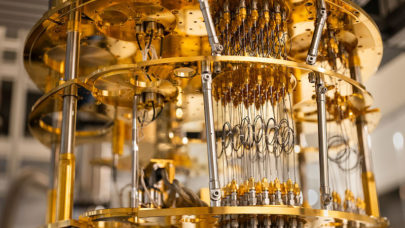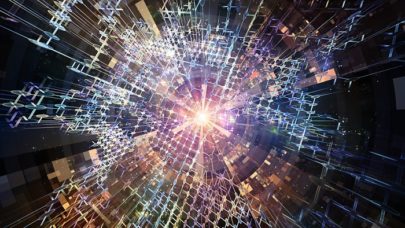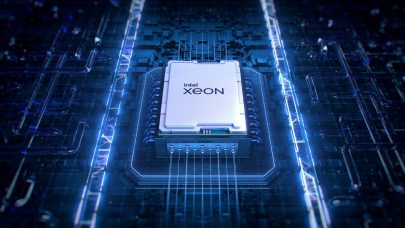How are stars made? — no, not pop stars and movie stars, the other kind, the ones that bring light to cosmic darkness. Like people, the brilliant light points in space have a birth-to-death cycle, and their birth is a tempestuous, uncertain process.
A star comes into being when a region of cold gas in a galaxy collapses — like a basketball contracting to the size of a dot — until the core gets so dense that the atoms begin to fuse. Astrophysicists mark the onset of nuclear fusion — when the thermonuclear furnace at a star's core starts to heat up — as the moment of star birth.
Not all galactic regions of collapsing gas, however, result in newborn stars. One scenario sees the birth process as a kind of competition between energies. Swirling, turbulent gas as it collapses builds up tremendous pressure, which — as it becomes dense enough — sends a sound wave outward. If this outward pressure wave travels fast enough, it can stop the collapse. On the other hand, if the collapse happens faster than the pressure wave's ability to slow it, known as Jeans instability, nuclear fusion starts and voilá — a new star.
Underlying this simplified scenario, however, is a complex stew of physical processes, with many factors involved, including temperature of the gas, its chemical composition, its magnetization, and the rate at which the collapsing gas cools. Depending on how galaxy behavior is understood, scientists have proposed numerous theories of star birth and have long sought a clear explanation.
Why do we care how stars form? Simple, says Mordecai-Mark Mac Low, an astrophysicist at the American Museum of Natural History in New York. Without star birth, there wouldn't be life. “Ultimately our research tells us why we are here,” he says. “In our models of star formation, we're basically trying to figure out how the galaxy we live in and all the galaxies we see around us behave. And how does that behavior contribute to our own presence?”
In recent work, Mac Low and colleagues Yuexing Li of Columbia University (now at the Harvard-Smithsonian Center for Astrophysics) and Ralf S. Klessen of the Astrophysical Institute of Potsdam (now at the University of Heidelberg) used LeMieux, PSC's terascale system, to simulate billions of years of galactic evolution. Their results cut through the galactic fog and reduce a complex story to one key element.
“Gravitational instability,” says Mac Low, “appears to be the dominant mechanism controlling the formation of stars.”
Sink Particles
To get to this conclusion, Mac Low's team modeled the matter within galaxies as particles, using a method called “smoothed particle hydrodynamics.” They implemented this approach with simulation software, called GADGET, developed by Volker Springel at the Max Planck Institute for Astrophysics in Garching, Germany. Instead of overlaying a fixed grid and monitoring changes within each cube of the grid — a common approach to modeling movement of objects in space — GADGET scatters particles across the galaxy, with each particle assigned an initial density, pressure, and velocity. The simulations track these particles — their changes in position, density, pressure and velocity — through billions of simulation years.
“Instead of a regular grid where the resolution is fixed everywhere,” says Mac Low, “you have an unstructured grid, where the resolution follows the gas flow. This is good if you're looking at problems of collapse, because you put the most resolution in the densest regions.”
Along with this advantage, however, the particle method imposes a challenging computational problem. When collapse starts, the particles crowd closer and closer, in tighter and tighter orbits about each other. Maintaining high resolution in such a region requires more and more computation to advance the same amount of physical time, which eventually leads to an impasse — to advance a year of galactic time can require a year of computation.
The solution is to let collapse proceed until it's certain the collapsing region will achieve critical stellar density, then replace the thousands of gas particles in this region with a single absorbing particle of the same mass and velocity — called a “sink” particle because it acts as a sink, as opposed to a source, of mass. In that region, LeMieux now has to track only one particle, instead of thousands. By measuring the mass of a sink particle, scientists can quantify how much gas has collapsed to form a star cluster. “Effectively it becomes,” says Mac Low, “a star particle.”
Mac Low first worked with sink particles on a cluster computer at the American Museum of Natural History before he approached PSC for time on LeMieux. “You don't want to get on a high-performance machine,” he says, “until you know where you're going and what you want to accomplish. Once we started our million particle runs, to do it right we needed something like LeMieux.”
Their model galaxies comprise a disk of stars and uniform temperature (isothermal) gas surrounded by a spherical “halo” of dark matter; picture a globe filled with dark matter and a swirling disk of gas and stars at the equator. Through a series of about 20 simulations of single galaxies, over nearly two years starting with the AMNH cluster and then with LeMieux, they varied the number of gas particles from one to six million, and they varied other parameters — the fraction of gas, the size and rotation rate of the galaxies, effectively varying the strength of gravitational instability — and observed the effect on star birth.
Gravity Rules
The results show that star particles form more readily in regions that are more gravitationally unstable. In disk galaxies, gravitational instability is known as Toomre (pronounced Toom-ray) instability, for Alar Toomre, who first described it in 1964.
The Toomre gravitational instability parameter quantifies how sensitive a region of gas is to changes in local conditions. If additional gas is added to the region, or the strength of rotational shear changes, how likely is it that this will initiate collapse? Regions with an instability parameter above 1.0 are relatively stable and vice-versa.
Two factors bear on Toomre instability: pressure support and shear support. Pressure support involves a sound wave traveling outward through a collapsing region, as described earlier. If the gas collapses faster than the sound wave can stabilize it, the region becomes pressure unstable, meeting the Jeans instability criterion.
The other factor is shear support, which takes into account the “differential rotation” of material orbiting in a disk. Particles close to the center of the disk revolve faster than particles at the outer edges, just as in our Solar System where planets distant from the Sun travel more slowly along their orbit than planets close to the Sun. Because of differential rotation, gas on one side of a collapsing region can shear away from gas on the other side before collapse occurs, preventing star formation. For Toomre instability, the gas region must collapse fast enough so that (1) sound waves can't provide pressure support, and (2) shear doesn't tear the region apart before it collapses.
Mac Low's simulations with LeMieux show that sink particles form more readily in regions where the Toomre gravitational instability parameter is smaller. This is true regardless of changes in other variables — galaxy size, quantity of gas particles, rotation rate and gas fraction of the galactic disk. The simulations identify an exponential relationship between the rate of star birth and the Toomre instability parameter. Therefore, Mac Low concludes, Toomre instability alone is sufficient to explain star formation.
This conclusion departs from a number of previous theories. Some theorists believe that cooling is key — if you cool the gas in a galactic disk to a low enough temperature, star formation will inevitably occur. Others argue that magnetic support is crucial, with star formation occurring only in regions sufficiently neutral to decouple from the magnetic field.
Mac Low's results, however, strongly suggest that these ideas are due for rethinking. “I'm arguing,” he says, “that cooling is incidental. The first thing you do is start the collapse, and if you raise the densities high enough, the cooling will happen very quickly, more or less regardless of details. Similarly, if a massive enough region collapses, magnetic support can simply be overwhelmed.”
To follow-up on these findings, Mac Low and his colleagues plan to simulate galaxies at finer and finer resolution until they reach the resolution of an individual star. Currently, he and M. K. Ryan Joung of Columbia University are using 1,000 LeMieux processors to simulate a small fraction of a galaxy — to test whether supernovas act as galactic “stirrers” that stir and heat gas, impeding collapse.
Better knowledge of how a star is born, he says, helps us to comprehend “the grand history that ends up producing a kind of average star two-thirds of the way out in a larger-than-ordinary galaxy, a star that happens to have planets around it — one of which we live on.”
For more information, including graphics: http://www.psc.edu/science/2006/starmaker/starmaker.php


























































